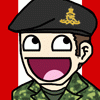
Well here is something I have not posted in ages on FA. Firearm art. The Boys, often misspelled as Boyes, Anti-Tank Rifle was developed for the British Army in the 1930s as a infantry portable weapon against many of the tanks then fielded by various armies of Europe.
While capable penetrating the armor of lighter tanks of that period the Boys was quickly eclipsed by advances in hull armor thickness and quality. It is to note though that most pre-war anti-tank weapons were quickly found to inadequate in the face of relentless armor vehicle development. Only the German 88mm which were initially used primarily as anti-aircraft guns finished the war as a still viable and feared anti-tank guns.
After some initial use in Finland, Western Europe and North Africa the Boys were quickly retired from these theaters; however the rifle continued to find itself useful in Asia were it was still adequate against the lightly armored vehicles of the Imperial Japanese Army. Here they soldiered on until around 1942.
The Boys was apparently never very popular with British Forces. According to some sources ordnance crews found it difficult to repair, and despite possessing a muzzle brake, monopod/ bipod, thick leather recoil pad and recoil absorbing stock troops still complained about the recoil from its .55 inch (13.9mm) cartridge. Although the Finns found them handy against lighter Soviet tanks like the T-26 during the Winter War of 1939-40.
Unfortunately as a concept the idea of the anti-tank rifle was doomed to the ever growing size and lethality of their primary prey. The tank. Also advancements in other more effective infantry anti-tank weapon systems like the Panzerfaust, PIAT, the Bazooka and assort shape charge grenades and mines render them redundant. Also most anti-tank rifles required careful machining and construction to allow them to safely chamber the cartridges they fired. They were heavy and awkward compared to the relatively cheap and compact systems like the Panzerfaust.
However the need for a large caliber infantry rifle never went away, its target just changed. During the Great Patriotic War the Soviets often used their ineffective against tanks PTRD and PTRS 14.5mm anti-tank rifles to destroy and snipe targets beyond the effective range and armor penetration capability of the main Soviet rifle cartridge the 7.62x54R. When the Korean War broke out there are accounts of forces on both sides of the conflict using large caliber rifles like the Boys or PTRD to carry out long range sniping mission in the mountainous terrain of the Korean Peninsula.
It wasn't until the 1980s though that these large caliber rifle found there true home as anti-material rifles. Today most major armies employ some variant of this weapon to destroy/dispose of unexploded munitions and IED's from safe distances, or to disable high value enemy targets and assets. A very well know weapon from this class of weapon is the Barret M82 family http://www.furaffinity.net/view/1046692/ . For the cost of a few dollars one round can destroy delicate electronics, antenna and sensors on vehicles and installations. Render enemy aircraft inoperable surgical placed rounds in strategic locations. And generally give forces in charge of perimeter security a bigger area to police and control. Of course counter measures to them are constantly being pursued and developed and the anti-material rifle may again one day find itself out of a job, but for the moment they have a role they fill very well.
While capable penetrating the armor of lighter tanks of that period the Boys was quickly eclipsed by advances in hull armor thickness and quality. It is to note though that most pre-war anti-tank weapons were quickly found to inadequate in the face of relentless armor vehicle development. Only the German 88mm which were initially used primarily as anti-aircraft guns finished the war as a still viable and feared anti-tank guns.
After some initial use in Finland, Western Europe and North Africa the Boys were quickly retired from these theaters; however the rifle continued to find itself useful in Asia were it was still adequate against the lightly armored vehicles of the Imperial Japanese Army. Here they soldiered on until around 1942.
The Boys was apparently never very popular with British Forces. According to some sources ordnance crews found it difficult to repair, and despite possessing a muzzle brake, monopod/ bipod, thick leather recoil pad and recoil absorbing stock troops still complained about the recoil from its .55 inch (13.9mm) cartridge. Although the Finns found them handy against lighter Soviet tanks like the T-26 during the Winter War of 1939-40.
Unfortunately as a concept the idea of the anti-tank rifle was doomed to the ever growing size and lethality of their primary prey. The tank. Also advancements in other more effective infantry anti-tank weapon systems like the Panzerfaust, PIAT, the Bazooka and assort shape charge grenades and mines render them redundant. Also most anti-tank rifles required careful machining and construction to allow them to safely chamber the cartridges they fired. They were heavy and awkward compared to the relatively cheap and compact systems like the Panzerfaust.
However the need for a large caliber infantry rifle never went away, its target just changed. During the Great Patriotic War the Soviets often used their ineffective against tanks PTRD and PTRS 14.5mm anti-tank rifles to destroy and snipe targets beyond the effective range and armor penetration capability of the main Soviet rifle cartridge the 7.62x54R. When the Korean War broke out there are accounts of forces on both sides of the conflict using large caliber rifles like the Boys or PTRD to carry out long range sniping mission in the mountainous terrain of the Korean Peninsula.
It wasn't until the 1980s though that these large caliber rifle found there true home as anti-material rifles. Today most major armies employ some variant of this weapon to destroy/dispose of unexploded munitions and IED's from safe distances, or to disable high value enemy targets and assets. A very well know weapon from this class of weapon is the Barret M82 family http://www.furaffinity.net/view/1046692/ . For the cost of a few dollars one round can destroy delicate electronics, antenna and sensors on vehicles and installations. Render enemy aircraft inoperable surgical placed rounds in strategic locations. And generally give forces in charge of perimeter security a bigger area to police and control. Of course counter measures to them are constantly being pursued and developed and the anti-material rifle may again one day find itself out of a job, but for the moment they have a role they fill very well.
Category All / All
Species Unspecified / Any
Size 1021 x 686px
File Size 78.4 kB
I've never fired any of this class of weapon although about a decade ago my father got a chance for some trigger time behind a Barrett M82a2 and was amazed at how easy it was to hit things at ranges he never imagined himself capable of shooting out to. Now admittedly he was just plinking full cans with the rifle resting across the hood of a truck, but the combination of effectively match ammo, top shelf optics, accommodating weather conditions, well designed ergonomics and some shooting skill made hitting targets out to a 1000yds+ a fairly routine task. What also amazed him was that the recoil wasn't nearly as bad as he had feared.
One variation of the SF tabletop RPG Traveller eventually introduced the "crunch gun" -- a large-caliber rifle that got its name from what happened to infantry in power armor when they became the gun's victims.
A BFG to be sure! Maybe you should visit a weapon museum in one of your dreamscapes?
A BFG to be sure! Maybe you should visit a weapon museum in one of your dreamscapes?
Ah the boys rifle.
Funny how I found in one WWII realism game Red Orchestra I and II, the people who get the PTRD and don't know about it try using it against the tanks only to watch it bounce.
But those who do know it historical capability would only look for half-tracks and infantry to hit, or the rear ass of the PanzerIV or T-34 or lower tanks.
Great job on the boys technical sketch.
Funny how I found in one WWII realism game Red Orchestra I and II, the people who get the PTRD and don't know about it try using it against the tanks only to watch it bounce.
But those who do know it historical capability would only look for half-tracks and infantry to hit, or the rear ass of the PanzerIV or T-34 or lower tanks.
Great job on the boys technical sketch.
The name's a big of a fun tail, too, as it's after one of its designers that had died before they finished it out.
Can't recall where I'd read it but on the Eastern Front (more the PTRD than the PTRS for it's ease of use) they had quite a fair bit of luck with their ATRs engaging in urban environments, given that the 'almighty panzers' tended to only have around 3/4 inches of armor plating (Panther, specifically, for that one) on the top. Not so effective on the Western Front, but the US had artillery out the rear for that.
Always wanted to fire one of these, once. Old ATRs are not shoulder-friendly, as mentioned.
Cheers.
-VV
Can't recall where I'd read it but on the Eastern Front (more the PTRD than the PTRS for it's ease of use) they had quite a fair bit of luck with their ATRs engaging in urban environments, given that the 'almighty panzers' tended to only have around 3/4 inches of armor plating (Panther, specifically, for that one) on the top. Not so effective on the Western Front, but the US had artillery out the rear for that.
Always wanted to fire one of these, once. Old ATRs are not shoulder-friendly, as mentioned.
Cheers.
-VV

 FA+
FA+























Comments